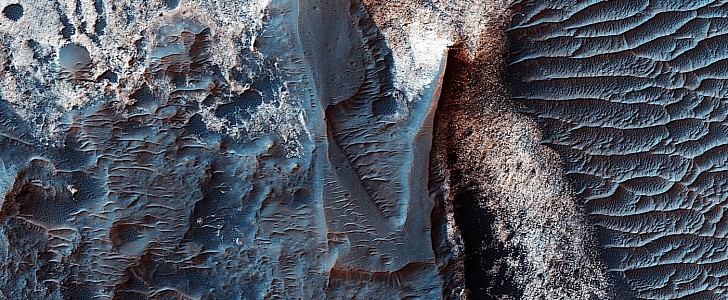If you’ve been watching our coverage of Martian stills sent back from millions of miles away by the HiRISE camera, you might have gotten the impression that, even if admittedly strange, the planet has a sort of predictability to it, at least as far as its main features are concerned.
What we generally get (and also expect to get) on Mars is reddish soil, dunes crisscrossing all around, and too many impact craters to accurately count. But there are places on the surface where nature seems to have had a lot more fun carving out intricate formations.
The chaotic scene before our eyes comes from such a place, more precisely from the Melas Chasma region. It’s a place we’ve seen before, filled with dunes that resemble creatures depicted only in sci-fi novels, now pictured from an altitude of 265 km (165 miles), as it was back in 2016.
This time, it’s not the dunes that take center stage, but large mounds of light-toned deposits. By large, scientists mean features that are miles thick, and by deposits, they generally mean a chaotic mixture of sulfates, clays, or some other hydrated materials.
While, admittedly, talk of sulfates and clays could be boring, especially when it comes to alien worlds, all of the above has a silver lining to it: most of the materials making up these features suggest “multiple aqueous processes, perhaps at different times within Valles Marineris, formed the variety of deposits we now observe.”
That means, in layman’s terms, water, one of the two Holy Grails (the other one being signs of life) that drive humanity’s need and desire of exploring the neighboring world.
We know the planet once harbored the substance, in abundance, and we know water still exists there, even if not in liquid form. And where there is water, to our knowledge, there’s a good chance there’s life.
The chaotic scene before our eyes comes from such a place, more precisely from the Melas Chasma region. It’s a place we’ve seen before, filled with dunes that resemble creatures depicted only in sci-fi novels, now pictured from an altitude of 265 km (165 miles), as it was back in 2016.
This time, it’s not the dunes that take center stage, but large mounds of light-toned deposits. By large, scientists mean features that are miles thick, and by deposits, they generally mean a chaotic mixture of sulfates, clays, or some other hydrated materials.
While, admittedly, talk of sulfates and clays could be boring, especially when it comes to alien worlds, all of the above has a silver lining to it: most of the materials making up these features suggest “multiple aqueous processes, perhaps at different times within Valles Marineris, formed the variety of deposits we now observe.”
That means, in layman’s terms, water, one of the two Holy Grails (the other one being signs of life) that drive humanity’s need and desire of exploring the neighboring world.
We know the planet once harbored the substance, in abundance, and we know water still exists there, even if not in liquid form. And where there is water, to our knowledge, there’s a good chance there’s life.






